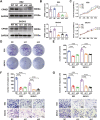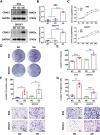Copine 1 predicts poor clinical outcomes by promoting M2 macrophage activation in ovarian cancer
- PMID: 37747823
- PMCID: PMC10773812
- DOI: 10.1093/carcin/bgad067
Copine 1 predicts poor clinical outcomes by promoting M2 macrophage activation in ovarian cancer
Erratum in
-
Correction to: Copine 1 predicts poor clinical outcomes by promoting M2 macrophage activation in ovarian cancer.Carcinogenesis. 2024 Mar 11;45(3):183. doi: 10.1093/carcin/bgad089. Carcinogenesis. 2024. PMID: 38069913 Free PMC article. No abstract available.
Abstract
Objective: Copine 1 (CPNE1), a membrane-binding protein, influences the prognosis of various cancers. According to cBioPortal, CPNE1 amplification is a prevalent genetic mutation in ovarian cancer but with unknown oncogenic mechanism.
Methods: This study analysed the CPNE1 expression in ovarian cancer using online datasets, as validated by immunohistochemistry (IHC), quantitative polymerase chain reaction (qPCR) and western blotting. Concurrently, the prognostic value of CPNE1 was accessed. Cell Counting Kit-8, colony formation, transwells and xenograft experiments were performed to evaluate the functions of CPNE1 during ovarian cancer carcinogenesis. CPNE1 and its related genes were analysed by g:Profiler and Tumour Immune Estimation Resource. Furthermore, human monocytic THP-1 cells were co-cultured with ES2 cells to investigate the effect of CPNE1 on macrophage polarization.
Results: The results of bioinformatic analysis, IHC, qPCR and western blotting indicated a higher CPNE1 in ovarian cancer. CPNE1 overexpression demonstrated an association with a poor prognosis of ovarian cancer. Functionally, CPNE1 overexpression increased ES2 and SKOV3 cell proliferation, invasion and migration in vitro and promoted ovarian tumour xenograft growth in vivo, while CPNE1 knockdown led to opposite effects. Additionally, CPNE1 expression demonstrated an association with immune cell infiltration in ovarian cancer, especially macrophage. CPNE1 promoted protumour M2 macrophage polarization by upregulating cluster of differentiation 163 (CD163), CD206 and interleukin-10.
Conclusions: Our study revealed that CPNE1 mediated M2 macrophage polarization and provided a therapeutic target for ovarian cancer.
© The Author(s) 2023. Published by Oxford University Press.
Conflict of interest statement
None declared.
Figures







Similar articles
-
Comprehensive analysis of prognostic value, immune implication and biological function of CPNE1 in clear cell renal cell carcinoma.Front Cell Dev Biol. 2023 Apr 3;11:1157269. doi: 10.3389/fcell.2023.1157269. eCollection 2023. Front Cell Dev Biol. 2023. PMID: 37077419 Free PMC article.
-
Exploring the role of copine 1 in human colorectal cancer: investigating its association with tumorigenesis and metastasis.Ann Surg Treat Res. 2023 Dec;105(6):385-395. doi: 10.4174/astr.2023.105.6.385. Epub 2023 Nov 29. Ann Surg Treat Res. 2023. PMID: 38076599 Free PMC article.
-
FPR2 participates in epithelial ovarian cancer (EOC) progression through RhoA-mediated M2 macrophage polarization.J Ovarian Res. 2021 Dec 20;14(1):177. doi: 10.1186/s13048-021-00932-8. J Ovarian Res. 2021. PMID: 34930387 Free PMC article.
-
MiR-217 Inhibits M2-Like Macrophage Polarization by Suppressing Secretion of Interleukin-6 in Ovarian Cancer.Inflammation. 2019 Oct;42(5):1517-1529. doi: 10.1007/s10753-019-01004-2. Inflammation. 2019. PMID: 31049770
-
CPNE1 predicts poor prognosis and promotes tumorigenesis and radioresistance via the AKT singling pathway in triple-negative breast cancer.Mol Carcinog. 2020 May;59(5):533-544. doi: 10.1002/mc.23177. Epub 2020 Mar 17. Mol Carcinog. 2020. PMID: 32181526 Free PMC article.
Cited by
-
A clinical prognostic model related to T cells based on machine learning for predicting the prognosis and immune response of ovarian cancer.Heliyon. 2024 Aug 24;10(17):e36898. doi: 10.1016/j.heliyon.2024.e36898. eCollection 2024 Sep 15. Heliyon. 2024. PMID: 39296051 Free PMC article.
-
Single-cell RNA sequencing of cervical exfoliated cells reveals potential biomarkers and cellular pathogenesis in cervical carcinogenesis.Cell Death Dis. 2024 Feb 12;15(2):130. doi: 10.1038/s41419-024-06522-y. Cell Death Dis. 2024. PMID: 38346944 Free PMC article.
-
Intrinsic immunosuppressive features of monocytes suppress CAR-T19 through IL-1 pathway modulation in mantle cell lymphoma.Mol Ther Oncol. 2025 Apr 19;33(2):200985. doi: 10.1016/j.omton.2025.200985. eCollection 2025 Jun 18. Mol Ther Oncol. 2025. PMID: 40458688 Free PMC article.
-
The role of macrophage polarization in ovarian cancer: from molecular mechanism to therapeutic potentials.Front Immunol. 2025 Apr 22;16:1543096. doi: 10.3389/fimmu.2025.1543096. eCollection 2025. Front Immunol. 2025. PMID: 40330466 Free PMC article. Review.
-
Multi-omics dissection of CPNE1 reveals its prognostic value and immune-regulatory function in liver cancer.Discov Oncol. 2025 Aug 7;16(1):1499. doi: 10.1007/s12672-025-03366-6. Discov Oncol. 2025. PMID: 40775545 Free PMC article.
References
-
- Siegel, R.L., et al. . (2023) Cancer statistics, 2023. CA. Cancer J. Clin., 731, 17–48. - PubMed
-
- Khiewvan, B., et al. . (2017) An update on the role of PET/CT and PET/MRI in ovarian cancer. Eur. J. Nucl. Med. Mol. Imaging, 44, 1079–1091. - PubMed
-
- Webb, P.M., et al. . (2017) Epidemiology of epithelial ovarian cancer. Best Pract. Res. Clin. Obstet. Gynaecol., 41, 3–14. - PubMed
-
- Lheureux, S., et al. . (2019) Epithelial ovarian cancer: evolution of management in the era of precision medicine. CA. Cancer J. Clin., 69, 280–304. - PubMed
-
- Bejarano, L., et al. . (2021) Therapeutic targeting of the tumor microenvironment. Cancer Discov., 11, 933–959. - PubMed
Publication types
MeSH terms
Substances
Grants and funding
LinkOut - more resources
Full Text Sources
Medical
Research Materials
Miscellaneous

